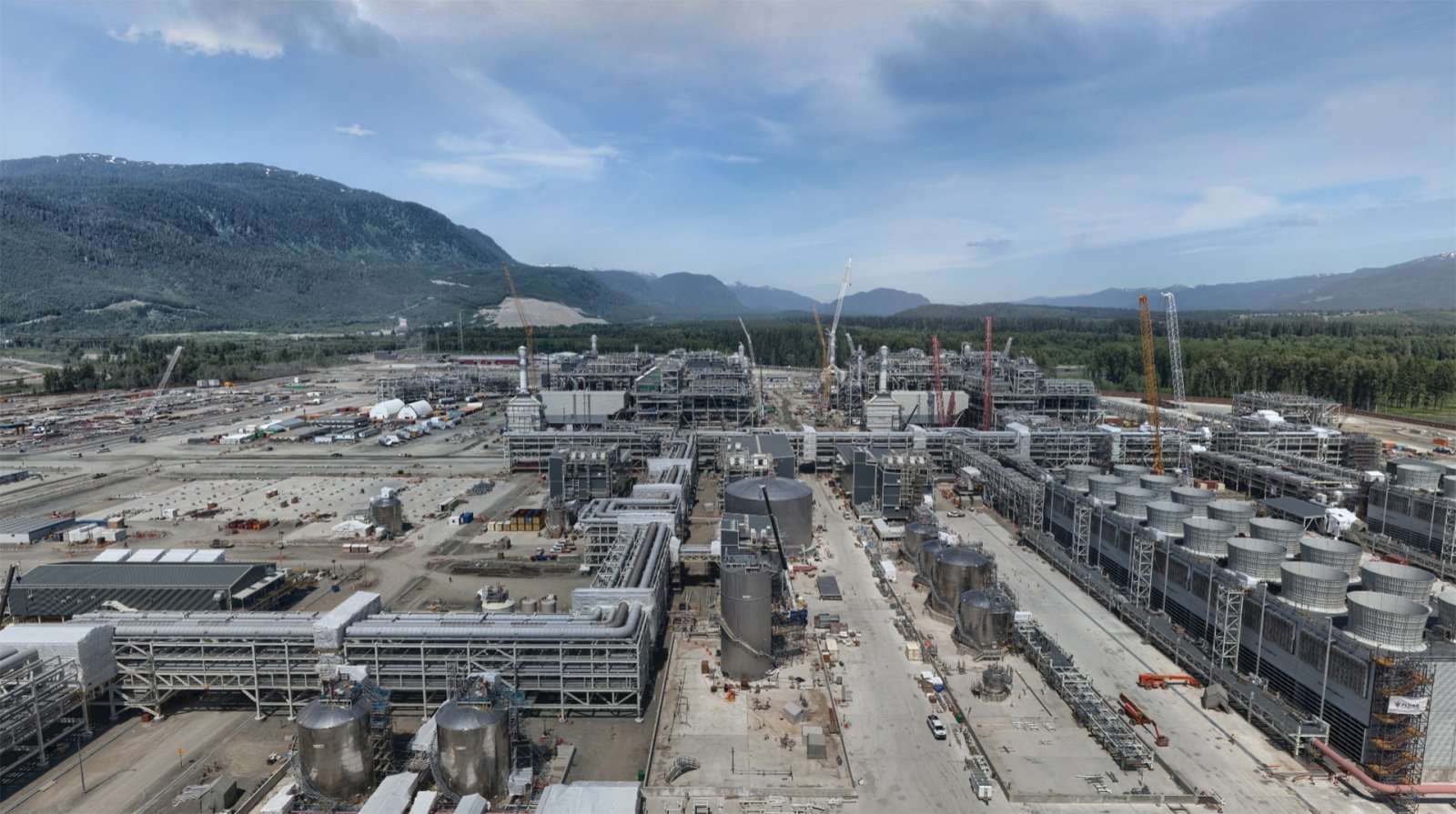Articles Menu

Aug. 1, 2023
As Canada rolled out a host of climate policies aimed at the fossil fuel industry, Shell sat down with Energy and Natural Resources Minister Jonathan Wilkinson to discuss the fate of its massive LNG project on the West Coast, documents reveal.
Shell requested a meeting with Wilkinson on April 27 to understand whether investment in the second phase of that project makes sense, Canada’s National Observer has learned. Attending the meeting was Wilkinson, assistant deputy minister for the fuels sector Erin O’Brien, Shell Canada president Susannah Pierce and Shell’s executive vice-president for LNG, Cederic Cremers.
The fossil fuel giant is building a liquefied natural gas (LNG) export terminal in Kitimat, B.C., called LNG Canada. At a cost of $48.3 billion (including the export terminal, the Coastal GasLink pipeline that feeds the terminal and the costs related to drilling for gas), LNG Canada Phase 1 is the largest private investment in Canadian history. When it opens, it will be the largest emitter of heat-trapping greenhouse gases in the province.
Shell is interested in expanding the site to export even more planet-warming natural gas with a second phase of construction. But these are long-term investment decisions. LNG Canada is expected to operate into the 2060s, and further investment will only increase the risk from the unfolding energy transition.
In the meeting with Wilkinson, Shell’s objective was to help the federal government understand “global market dynamics and Shell's work to align [LNG Canada] Phase 2 with climate objectives,” according to a brief prepared for Wilkinson ahead of the meeting, which Canada’s National Observer received through a federal access-to-information request.
The briefing note sheds light on the delicate communications between oil and gas companies and the federal government as climate policies designed to lower planet-warming greenhouse gas emissions come into effect. Because climate science is clear that the only way to avoid disastrous global warming is to phase out all fossil fuels as quickly as possible, the tougher Ottawa gets on the sector, the less likely it is that oil and gas companies will be able to increase their production.
For years, the federal government has tried to walk a line between supporting the oil and gas sector and responding to climate change by cutting domestic emissions while simultaneously increasing fossil fuel exports. Both the federal government and industry have promised an unmatched economic opportunity that could also curb emissions by supplying gas to Asian countries as they phase out coal. But that business case now appears to be coming off the rails.

The market in Asia, where Canadian LNG would be destined, is shifting. Since Russia’s invasion of Ukraine pushed some European countries to close the door on Russian gas, Russia has quickly pivoted to Asia, upgrading its relationships with countries on the continent, particularly China, as a key priority just behind Eastern Europe. It now appears Russia intends to pivot to Asia for the long haul. Exporting gas is a central pillar of that strategy.
The market for Canadian LNG is shifting as Russia pivots to Asia for gas exports, suggesting competitiveness challenges are mounting, documents obtained by @NatObserver reveal. #cdnpoli - Twitter
"How are Russia's gas pivot toward Asia and the pace of the energy transition affecting LNG markets in general?” and “What competitiveness challenges exist for Canadian LNG in Asia?” are listed as “points to register” in the meeting note.
Shell did not directly answer questions posed by Canada’s National Observer about how Russia’s pivot to Asia is affecting the business case for LNG Canada. Instead, it claimed that exporting natural gas will reduce global greenhouse gas emissions, even though natural gas is a fossil fuel that drives global warming. While true gas creates fewer CO2 emissions than coal, extracting and transporting natural gas results in leaked methane — a greenhouse gas that’s 86 times more potent than CO2 over a 20-year period, making it a vital greenhouse gas to tackle on the road to net-zero emissions by 2050.
It is not known if Wilkinson asked the questions provided to him in the briefing note or how Shell responded. Wilkinson did not return requests for comment by deadline.
Marc Lee, senior economist with the Canadian Centre for Policy Alternatives, told Canada’s National Observer that Russia’s pivot to Asia could seriously affect the business case for West Coast LNG projects generally, but LNG Canada specifically is better insulated from risk than others.
That’s because beyond Shell, LNG Canada’s owners include PetroChina (China’s largest oil and gas producer and supplier), the Korea Gas Corporation (South Korea’s main LNG importer), Mitsubishi Corporation (which owns more than a 50 per cent share of the LNG exports into Japan), and energy giant Petronas (Malaysia’s state-owned oil and gas company). The companies also own huge swaths of the gas deposits in northern B.C. called the Montney Formation, which feed LNG Canada via the Coastal GasLink pipeline. The gas exported from LNG Canada would be sold to South Korea, Japan, Malaysia and China.
“It's basically a buyer's cartel,” Lee said. “They've already got their market. They're not producing LNG and they don't know who is going to buy it. They're going to buy it.”
That’s quite different from the other LNG projects in development that would be selling into a market and needing the price of gas to stay above a certain level to stay profitable, Lee said, referring to four other potential LNG export sites dotting the British Columbia coast in various stages of development.
Russia’s pivot to Asia isn’t the only issue for fossil fuel companies trying to increase production in Canada.
Following years of pressure from environmental advocates, Canada is now seeing a flurry of policy developments, from an emerging cap on oil and gas sector emissions to new rules curbing subsidies to the fossil fuel sector. Climate advocates say these policies, if implemented properly, could help shift the Canadian economy to a cleaner future. Shell sees them as a threat to its bottom line that could upend the business case for LNG expansion.
Shell’s forecasts predict the demand for LNG will grow significantly, with a major supply gap starting mid-decade and rising through 2040. For that reason, the company is looking to increase its exports to fill the gap and believes LNG Canada Phase 2 could play a role. However, a lot rides on Canada’s forthcoming emissions policies, which will inform the company’s investment decisions, according to the meeting note.
“Industry is closely watching the development of positions and policies on topics including the oil and gas emissions cap, enhanced methane regulations, inefficient fossil fuel subsidies (IFFS), international carbon credit offsets” and other programs that could affect competitiveness, reads the meeting note.
Fundamentally, the energy and climate change policies chosen today determine whether or not long-term fossil fuel projects can be commercially viable. LNG could continue to grow if policies to slash greenhouse gas emissions aren’t put in place, according to the Canada Energy Regulator’s (CER) June forecasts. However, if policies to cut emissions are adopted globally, LNG demand could start to fall as soon as 2026, the report notes. Regardless of other countries, if Canada imposes credible emission reduction policies, the CER anticipates LNG demand falling after 2030.
Lee said these types of conversations between government and industry are “fascinating and disturbing.”
“We should actually be ramping [fossil fuel projects] down based on what's happening in the climate, and yet we're trying to find ways of making projects go ahead while simultaneously bringing in climate policies,” he said.
“The two have always been in contradiction, and they just get more and more [contradictory] with each passing year,” Lee said of policies aimed at fighting climate change while supporting the fossil fuel sector.
The federal government has given LNG Canada $275 million in support while also developing policies like an oil and gas emissions cap. In recent years, Ottawa has also adopted a carbon tax, clean electricity regulations and more, while simultaneously building the Trans Mountain pipeline expansion project and approving Bay du Nord, Canada’s first deepwater oil project, which is currently on hold. Taken together, it’s why environment commissioner Jerry DeMarco has repeatedly described what he sees as policy incoherence.
The LNG Canada owners have “got the Canadian government giving them tax breaks, they've got the B.C. government giving them tax breaks — they're getting gas for a song, and they just have to pay for this LNG facility,” Lee said.
In a recently published analysis, Lee specifically points to an agreement LNG Canada has with the B.C. government that caps its carbon tax at $30 per tonne, despite the national carbon price rising to $170 per tonne by 2030. This “represents a growing annual subsidy to LNG Canada,” he wrote.
[Top photo: Minister of Natural Resources Jonathan Wilkinson arrives to take part in a press conference on Parliament Hill in Ottawa on Thursday, June 15, 2023. THE CANADIAN PRESS/Sean Kilpatrick]